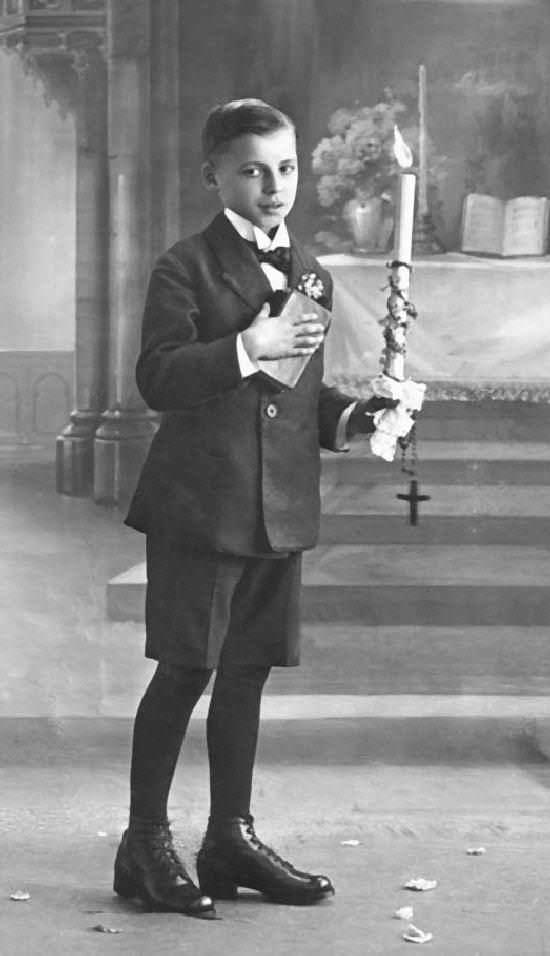
First Communion Country Trends: Destinctive German Portraits

Figure 1.--This German boy was photographed in 1932. Note the candel he carries with a fake flame. Many German boys were photographed with these candels. The old fashioned wing collar and long stockings help to date the portrait to the 1920s or early 1930s. After the NAZI take over in 1933, long stockings became less common. A caption at the top of the card read, "Heartfelt blessed wishes to (your) first holy communion". (Herzlichen Segenswunsch zur ersten heiligen Kommunion.) Image courtesy of the MD collection.
|
|
Destinctive Characteristics
There are some similarities in the German first communion portraits to the portraits taken elsewhere. The German boys commonly have their rossaries and Bibles. The rossary of course conform that these boys were Catholics. The major difference is that very commonly the German boys are photographed with a large lit candel. This was common in the portraits that we have noted from the early 20th century and we note also note it portraits taken through the 1950s. The clothes seen here in the portrait suggest that the boy was probably photographed on the 1920s or early 1930s. He wears an old fashioned wing collar and long stockings with his dark short pants suit. This helps to date the portrait to the 1920s. After the NAZI take over in 1933, long stockings became less common.There is another difference. Most German boys do not appear to wear the shoulder devices, ribbons and bows, that were common in some other countries. The shoulder devices that we do see look somewhat different. The boy here does not have a shoulder device.
In the case of this portrait we happen to know not only when it was taken, but we know how this boys' friends were dressed. The image is a photo postcard, several of which were sent to the same boy and are post marked in 1932. Presumably friends in Germany exchanged their First Communion portraits with each other. It is interesting to note the similarities and differences among the suits the boys wear. The boys mostly wear old fashioned wing collars. One boy wears a sailor suit. The boys except for one wear short pants suits. All of the boys with short pants wear dark long over-the-knee stockings, although kneesocks had become much more common for boys this age. The boys look about 12-14 years old. The lock stockings are not worn for warmth, but here appear to be considered more formal and appropriate for church than kneesocks.
HBC

Navigate the Boys' Historical Clothing Web Site religious pages:
[Return to the Main German first comminion page]
[Return to the Main First Communion country page]
[First Communion]
[Confirmation]
[Ring bearer]
[Victorian wedding]
Navigate the Boys' Historical Clothing Web Site:
[Introduction]
[Activities]
[Biographies]
[Chronology]
[Clothing styles]
[Countries]
[Bibliographies]
[Contributions]
[FAQs]
[Glossaries]
[Images]
[Links]
[Registration]
[Tools]
[Boys' Clothing Home]
Navigate the Historic Boys' Clothing Web chronological pages:
[The 1920s]
[The 1930s]
[The 1940s]
[The 1950s]
[The 1960s]
[The 1970s]
Navigate the Historic Boys' Clothing Web style pages:
[Short pants suits]
[Blazers]
[Jackets]
[Kilts]
[Sailor suits]
[Sailor hats]
[Ring bearer/page costumes]
[Shortalls]
Created: June 7, 2002
Last edited: June 9, 2002



